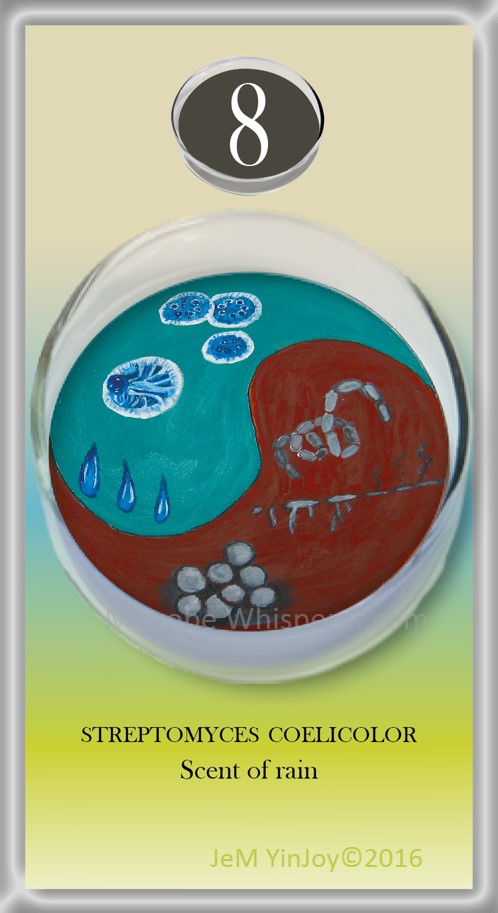
Haiku for S. Coelicolor
Stunning colors, droplets of defense,
Cleans soils and leaves,
Fresh rain scents.
Dr. JeM YinJoy
How to pronounce Streptomyces coelicolor.
Streptomyces coelicolor (Strep-TOE-MY-Sees Cole-eih-color)
The Spiritual Significance
If I were Queen of the World, I’d wave my scepter and declare the all waste and toxins that pollute our earth to disappear! Ok, maybe that’s more like channeling a Fairy Godmother with her magic wand.
Either title will do, for the deep, rich plush carpets formed by S. coelicolor actually do accomplish an almost miraculous cleansing of pollutants in the soil!
Oozing jeweled antibiotic droplets from luxuriously textured rugs of colorful mycelial mats, and filaments that snake out, branch-like, to disperse their spores, is it any wonder that S. coelicolor has become a Queen, a Fairy, a movie star and a glamorous diva – for its fantasy-evoking presence and colorful life-style?
Microbiologists have filmed S. coelicolor, creating time-lapse video to discover secretes to its unusual filamentous growth patterns. As it is, S. coelicolor cannot grow without oxygen – it has the genes, but doesn’t grow anaerobically – how mysterious! And it harbors some weirdly shaped plasmids too, some straight and some circular, where most other bacteria only have the circles, flaunting its uncommon nature once more.
These are just a few of the unusual-for-bacteria features that have microbiologists chasing after it for all its intimate details.
But S. coelicolor does also sport identifiable claims to fame
S. coelicolor turns red in acidic and or blue in basic environments, so it acts like a natural litmus paper strip.
S. coelicolor looks like a fungus and acts like a fungus, but it is a bacterium at “heart”.
It creates branches of hyphae from a sinuous filamentous chain of cells, and produces spores from antennae poking out of these branches and does so by a process that eukaryotes and multicellular organisms do often, but bacteria, not so much.
To keep predators and competitors at bay in its natural soil environment, S. coelicolor wields a personal, well-stocked pharmacopeia of antibiotics.
Some of its pigmented antibiotics are being used to develop anticancer agents because they are toxic to cancer cells.
Ironically – although S. coelicolor forms colonies that flow like designer garments from the waist of a high-maintenance celebrity, it’s merely a clever disguise for its bare-foot “Earth Mama” persona. This is because S. coelicolor it is responsible for one of earthiest fragrances know to humans – the unmistakable aroma, petrichor, that exudes from soil after a refreshing rain.
All of this notoriety and well-deserved fame are some of the reasons S. coelicolor has microbiologists rolling out the red carpet for its tendrils, and begging for its multicolored autograph.
The Microbiology
Streptomyces coelicolor, is a filamentous, gram-positive bacterium that was discovered on a potato in 1908.
Streptomyces produce a chemical called geosmin that is responsible for the “scent of rain” and also that strong smell when soil is disturbed. Humans can smell geosmin at extremely low concentrations.
Streptomyces act very much like fungi in their life cycle.
They develop a vegetative mycelium from a spore, then they shoot up strands called ariel mycelia that develop spores for the cycle to start all over again.
Usually bacteria divide by cell division, creating two totally separate sister cells.
But due to its ability for cell differentiation, Streptomyces create chains of cells linked together to form a branching mycelium network.
How it eats
Streptomyces coelicolor live in the soil, and can feed on a wide variety of carbon sources, such as glycerol, L-arabinose, D-arabitol, D-ribose, D-xylose, L-xylitol, D-fructose, D-galactose, to name a few. Some of its nitrogen sources are aspartate, asparagine, glutamate, glutamine for example.
Usually, a bacterium that has the ability to metabolize so many different food sources can do so by fermentation, by growing anaerobically. But Streptomyces is a surprise as it is an obligate aerobe, and it cannot grow anaerobically by fermentation.
What it does for the environment
Streptomyces coelicolor cleanse the soil, because they make quick work of the organic debris left from other organism’s remains.
They can degrade chitin and other compounds that most bacteria cannot digest and this gives them a large role in the global recycling of carbon.
Streptomyces coelicolor also plays a role in the nitrogen cycle. As a decomposer, Streptomyces coelicolor, converts nitrite to ammonia, which is a major step in the nitrogen cycle.
Streptomyces coelicolor is part of the genus Streptomyces, which produces antibiotics useful to human medicine. Streptomyces coelicolor produces antibiotics as a chemical defense mechanism, to ward off predators and competitors in its natural soil environment.










Comments 3
Greetings! I know this is kinda off topic but I’d figured I’d ask. Would you be interested in trading links or maybe guest writing a blog post or vice-versa? My site covers a lot of the same subjects as yours and I feel we could greatly benefit from each other. If you are interested feel free to send me an e-mail. I look forward to hearing from you! Great blog by the way!
HI. I might be interested. Please use my “Contact Me” page to send me more info. Joy, JeM
Great post! Have nice day ! 🙂 oct10